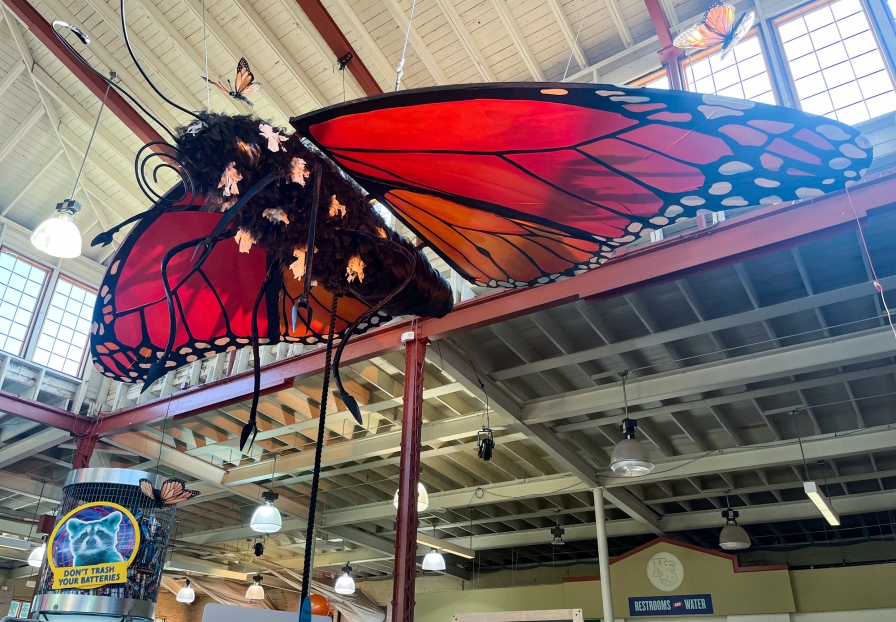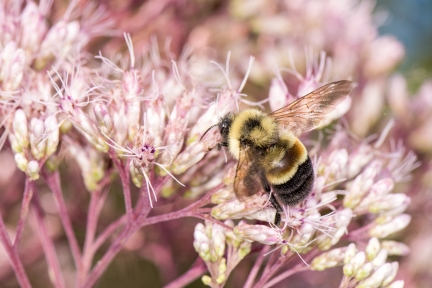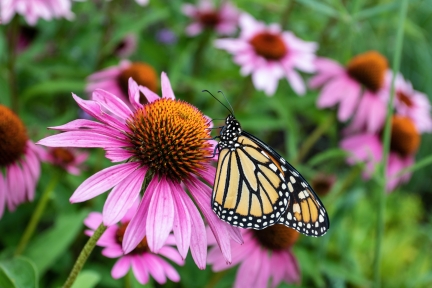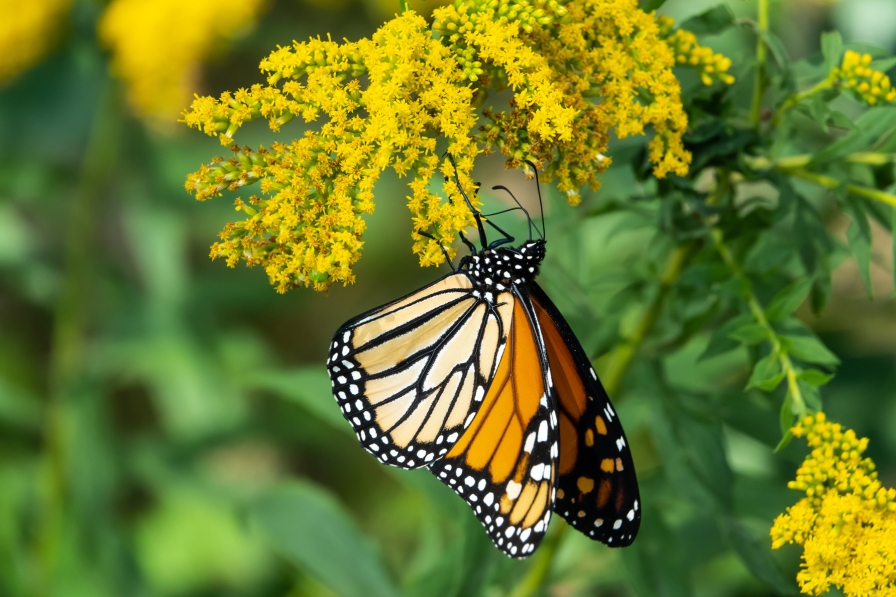
So, what’s the buzz at Eco Experience 2025? Pollinators, of course! Pull a rope to make a giant monarch flap its wings, win a rusty patched bumble bee pin for Eco Bingo, and most importantly, learn why these pollinators are so vital to Minnesota.
Scientists from the Minnesota Pollution Control Agency (MPCA), the Environmental Quality Board (EQB), and Blue Thumb will be at Eco Experience to answer your burning (or should we say stinging) pollinator questions.
“We like to feature beloved creatures, like the bumble bee or the monarch, that are also connected to the work at MPCA,” said Britt Gangeness, environmental education and outreach supervisor. “They’re a symbol of our state, and it helps people see how they can protect these insects.”

Pollinators are essential to everyday Minnesotans, our economy, and our food production. According to the USDA, almost 80% of crop plants require pollination, and globally, pollinators’ services are worth about $3 trillion. But these butterflies, bees, bats, bugs, and so much more are threatened by climate change, which is why raising pollinator awareness is essential.
Exhibits at this year’s Eco Experience put a spotlight on Minnesota's most iconic pollinators, helping visitors get to know some of the insects in their own backyard and providing simple tips on how to make them feel at home.
Both the rusty patched bumble bee and the monarch butterfly experience the plight of many pollinators, such as habitat fragmentation, climate change, urban development, diseases and parasites, and pesticide exposure. Pollinators are now found in fewer places and in fewer numbers than they used to be since climate change has shifted growing zones for their favorite plants.
Pollinator habitats are endangered, for example as Minnesota loses its native prairie land, with only 1% of the native prairie it once had.
“Monarchs in particular are a good ambassador species because they’re so iconic,” said Rebeca Gutierrez-Moreno, state pollinator coordinator at the Minnesota Environmental Quality Board and lead of the interagency pollinator protection team. “It can be easy to see if something is going wrong because you can visibly see the numbers decline.”
Gutierrez-Moreno explains that climate change and shifts in Minnesota’s flowering season create a mismatch for when pollinators can find food. If a flower that typically blooms in spring flowers too late or too early, by the time pollinators emerge, they may miss out on food, and the flower will miss out on pollination.
“That’s why planting pollinator-friendly gardens that blooms from early spring to fall is so important, so the pollinators have more opportunities to find food,” said Gutierrez-Moreno.
EQB plays an important role in coordinating interagency actions to protect pollinator habitat in Minnesota and educating Minnesotans on how they can spot pollinators and take action to protect the pollinators in their backyard.
Much of their work stems from Executive Order 19-28, which tasks state agencies to prevent pollinator habitat loss while also educating the public about the work pollinators do for our state. Part of this work includes simply making pollinators more visible to Minnesotans.
“Sometimes just learning about nature opens up a sense of wonder, and that is a cool opportunity that we get when we learn about pollinators,” Gangeness said.
Get to know the rusty patched bumble bee

Because one of the first steps to help pollinators is learning more about them, here are some fun facts about Minnesota’s state bee and butterfly:
- The rusty patched bumble bee has been Minnesota’s state bee since 2017.
- It is native to eastern North America and is currently an endangered species.
- This bee gets its name because males and worker bees have a patch of brown/orange hairs on the second segment of their abdomen, visible from the top.
- Rusty Patched Bumble Bee queens don’t have a rusty patch and are only seen during the spring (looking for a place to build a nest), and fall (looking for a place to overwinter).
- These bees are important pollinators of wild plants and crops. They are generalists, which means they like a wide diversity of flowers, and don’t depend on a single species.
Get to know the monarch butterfly

- The monarch butterfly was named Minnesota’s state butterfly in 2000.
- As many as 50 million monarchs fly south each fall.
- It takes about one month for a monarch egg to grow into an adult butterfly.
- Male and female monarchs can be distinguished by a black scent gland on each hind wing of the males.
- Approximately four generations of monarchs are born in Minnesota each summer.
How you can help pollinators
The best thing you can do for pollinators is increase their habitat by planting a few pollinator-friendly plants or designating a spot in your yard for a pollinator garden.
“Even planting flowering plants in a pot outside your apartment or condo makes a difference. You don’t have to have a big yard to help,” said Gutierrez-Moreno.
Stop by the Environmental Quality Board booth at Eco Experience on Thursday, Aug. 28, on Pollinator Day to get your own seed packet to start your pollinator garden. These native seed packets will have a mix of Minnesota-specific seeds that are suitable to plant throughout the state.
“What is really rewarding about a pollinator garden is that if you plant one, the pollinators will actually come,” Gangeness said. “You’re building up their habitat, so you’re guaranteed to see them.”
Aside from planting pollinator gardens and reducing pesticide use, there are community science programs like Bumble Bee Watch that help track bumble bees or Monarch Watch, which recruits regular people to tag monarchs.
Planting your pollinator garden
If planting a pollinator garden is right for you, there are a few things to consider first. Most importantly, make sure to plant species that are native to your region. The Xerces Society offers pollinator plant lists that show which plants are okay to plant based on where you live. For Minnesota, the Great Lakes and Northern Plains lists have the plants most suitable for this region. Hyssop, varieties of milkweed, goldenrod, and aster are among the many plants that will attract both bees and butterflies.

Consider how much sun your yard gets. Pollinator plants are often full-sun plants, though there are a few pollinator-friendly plants that thrive in the shade. And don’t forget about trees and shrubs, which can provide needed habitat for wildlife in addition to pollinators.
Pollinator gardens are easier to tend to than traditional lawns in the long-term, but they will require continued maintenance for the first few years.
“Patience is needed,” said Gutierrez-Moreno. “Don’t be discouraged if the first year isn’t great.”
Pollinators also need a variety of habitats. Pollinators require undisturbed patches where they can create their nests or have their overwintering habitat. That’s how they can survive the harsh Minnesota winters. Leaf litter from trees and other plants on top of the soil is a great way to build up a protective layer for overwintering habitat.
Choosing plants that will bloom throughout the growing season ensures pollinators have plenty of food too. Planting pollinator gardens helps connect available habitat that may be scattered around the state. Many urban areas end up being deserts for pollinators, so even small spaces help fill that gap.
The Pollinator Toolbox from the Board of Soil and Water Resources has a great guide to plan your next gardening project. It describes how to prepare your soil, gauge how much sun your backyard gets, and decide which pollinators you want to attract.

If a full pollinator garden isn’t for you and you want some patches of traditional lawn, a bee lawn might be for you. These lawns are a mix of low growing flowers and low maintenance turf grass that help keep a manicured lawn look, while providing food for pollinators. This is a great option for people with kids who still want a space to play on the lawn.
“For those worried about bees and wasp stings, remember that most of these insects won’t do anything to you if unbothered. They’re just here to eat and then leave,” said Gutierrez-Moreno.
Traditional lawns with turf grass are very demanding and high maintenance. But native grasses require less mowing, less water, and are adapted to the weather in Minnesota.
“We also need to rethink our perception of what is beautiful. Some people might think a pollinator garden full of native plants looks too wild, but there are lots of options to create a garden that brings us joy and provides a refuge for pollinators,” said Gutierrez-Moreno.
Pollinators are essential to Minnesota, and learning more about them is just one step to support pollinator health in your community.
“We can’t live without them,” said Gutierrez-Moreno. “We need each other.”